 SAFETY ALERT – If you are in danger, call or text 911.
SAFETY ALERT – If you are in danger, call or text 911.
2021–2026
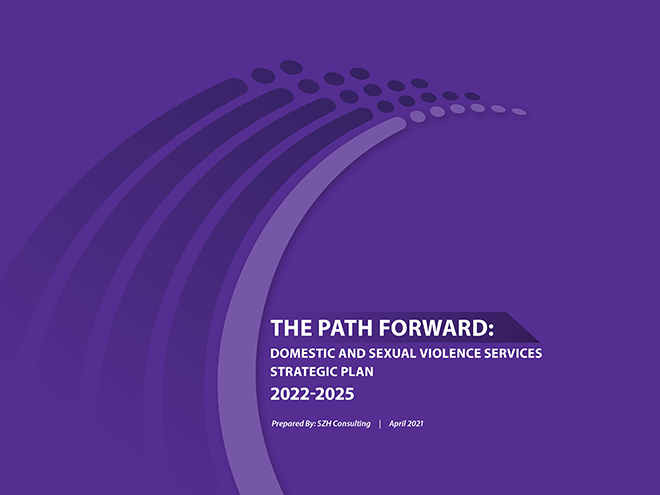

 SAFETY ALERT – If you are in danger, call or text 911.
SAFETY ALERT – If you are in danger, call or text 911.


On behalf of the Department of Family Services’ Division of Domestic and Sexual Violence Services (DSVS), I am pleased to present our 2021-2026 strategic plan to improve services to residents of Fairfax County and enhance collaboration with partners, non-government organizations (NGOs), community groups and key stakeholders.
This plan represents a culmination of nearly three years of deep organizational analysis guided by strategic reflection. We studied the history of racial and social justice movements, and their impact on the field of interpersonal violence. We gathered input from community partners and stakeholders and reviewed best practices. We analyzed data to identify the most impactful actions we can take in the next five years to support all persons impacted by interpersonal violence. Collectively, we decided our path forward.
When we started this journey in Spring, 2018, we never imagined how the world and our communities would forever be changed by the devastation of the COVID-19 pandemic and the social injustices that shook our collective conscience. It is under this context that DSVS finalized our mission, vision and values. Although Fairfax County adopted the One Fairfax policy in the Fall of 2017, the murder of George Floyd brought disparities and issues of social justice to the forefront. We placed equity and access in the center of our planning process to inform our approach for how we can better serve those who need us the most.
We have been altered. There is no going back.
During the pandemic, interpersonal violence increased in number and severity as layoffs, stay-at-home orders, and income loss exacerbated situations at home, which were already unsafe for many. The Department of Family Services, like many agencies around the nation, quickly pivoted to provide virtual services. DFS took a people-focused approach and centered ourselves on the personal health and safety of the staff and our community members while continuing to provide high quality services. As a bonus, we discovered the value of improved technology on our ability to serve the community and engage our partners. We learned the importance of flexibility and agility.
We are different now…more nimble…more resilient...more strategic. This strategic plan reflects all we have learned about ourselves and our communities.
On behalf of the DSVS leadership team, I invite you to review the plan and share in our excitement about the future. We look forward to working side by side with our partners and stakeholders to create and strengthen collaborative efforts to improve the safety and wellbeing of all persons impacted by interpersonal violence.
I am eternally grateful for the contributions of DSVS staff, partners, and survivors in the development of this strategic plan and I look forward to these ideas becoming action.
Sincerely,
Division Director, DSVS

In January 2020, the Department of Family Services Domestic and Sexual Violence Services (DFS-DSVS) kicked off an effort to develop a three- to five-year strategic plan, to optimally meet the needs of the community, and the various stakeholders that it serves. This plan was developed to ensure alignment of goals, objectives, and priorities with Fairfax County’s overarching strategic plan and goals to provide equitable outcomes for all Fairfax residents.
The DSVS Strategic Plan was completed in April 2021 and was designed to ensure that planning for the future is set on a firm foundation. Core to this strategic planning effort is the alignment with the Countywide Strategic Plan and the One Fairfax Policy, in order to meet the needs of the community and advance the work on efforts to mitigate racial and social inequities, and ultimately advance equity. The Department has worked to align these areas and create a shared vision for our workforce. Under the leadership of Toni Zollicoffer and the DSVS Strategic Plan Steering Committee (Appendix A), the group worked over a period of fifteen months to reconceptualize our vision, mission, and core value statements using the lens of One Fairfax and the goal of partnership in making a collective impact with the Strategic Plan.
The following principles guided the strategic planning work:
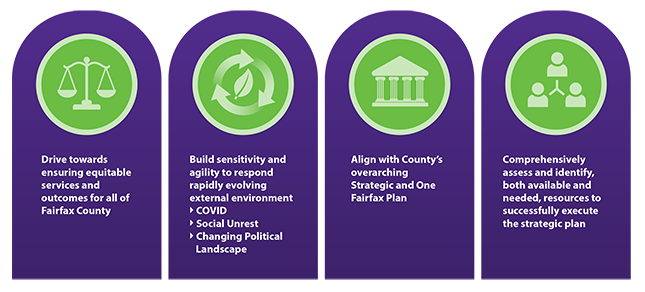

The Department of Family Services focuses on:
These services mitigate crime, abuse, and neglect; lessen the strain on public safety and judicial resources; increase the workforce and tax base; improve self-sufficiency and educational outcomes; and create an environment where all residents have opportunities to contribute to the success of the community. They are delivered collaboratively and with compassion, through people-focused practices that encourage innovation and demand accountability.
The DFS mission statement defines who we are and what we do. A vision statement defines what we aspire to be. Values are the guiding principles that shape our behavior and actions. Together this triad serves as the foundation for the Department of Family Services from which structures are built, plans are developed, and services are provided. The strategic goals that we develop within our program areas—and in concert with the County’s strategic priorities—are what we strive to do in support of the values and our daily activities on behalf of the people we serve and those who serve them. Together these elements make our agency a stronger, focused organization.
The Department of Family Services (DFS) strengthens the well-being of our diverse community by protecting and improving the lives of all children, adults, and families through partnership, advocacy, outreach, and quality services.
Fairfax County is a community where everyone lives their success story and thrives.
![]()
![]()
![]()
![]()
![]()

The Department of Family Services’ Domestic and Sexual Violence Services (DSVS) offers compassionate and comprehensive state-accredited programs for adults, teens, and children who have been affected by domestic and sexual violence, stalking and human trafficking. DSVS also offers services to coordinate and improve systems’ and communities’ responses to domestic and sexual violence, human trafficking, and stalking.
DSVS administers a variety of programs and services designed to improve the safety and well-being of individuals, families, and communities. These programs and services provide essential support for County residents who face multiple, often overlapping challenges and vulnerabilities. DSVS’ services are offered virtually and in person at multiple sites in Fairfax County. The services directly provided by DSVS and in partnership with community organizations provide the framework for a strong, equitable, and resilient Fairfax County: safe communities, a thriving economy, improved quality of life, and opportunities for everyone to feel connected and engaged.
Specifically, DSVS provides the following services and programs.
ADAPT
Anger & Domestic Abuse Prevention and Treatment. We offer a certified 18-week domestic abuse intervention program that will teach you skills to prevent abuse through the development of compassion for yourself and others.
Advocacy Services
We offer information, referrals, and support with a plan to help keep you safe. We help you through the court process, assist you with protective orders, and attend court hearings with you. We also offer guidance with housing and economic options.
Community Engagement Services
Community Education, Outreach, and Prevention. We offer workshops, talks, and table displays for community and faith-based groups, businesses, and schools.
Training and Guidance
We offer training, guidance, and support for people who work with victims and survivors.
Exam for Victims and Survivors
Our staff and volunteers will meet you at the Inova Fairfax Hospital Ewing Forensic Assessment and Consultation Team (FACT) Department to provide you with support.
Domestic and Sexual Violence 24-Hour Hotline 703-360-7273
We offer information, referrals, guidance, and support to help keep you safe. We are available by telephone 24 hours a day, seven days a week.
Emergency Shelter: Artemis House
We connect victims and survivors to emergency shelter and support. Available 24 hours a day, seven days a week.
Volunteer Services
You can help make a difference! Volunteers are an important part of our mission in providing support to our community.
Counseling Services
We offer counseling services for you and your family. Services include individual and family counseling for children and teens who have been sexually abused or have seen domestic violence. We also offer group counseling.
Countywide Coordination
We bring our community together to figure out what barriers exist and how to overcome them.

DSVS mission, vision, and core values frame and operationalize our services and are aligned with the County’s Strategic Plan, One Fairfax, and DFS Strategic vision.
Mission
We work with communities to transform society’s response to domestic violence, sexual violence, human trafficking, and stalking by challenging oppression, collaborating to inform policy and providing all persons impacted by violence with equitable access to trauma informed support, advocacy, education, and a space for healing.
Vision
Peaceful, thriving, powerful communities where all people are safe and free from oppression, fear, and violence.
Core Values
Preparing for Strategic Planning
In the Spring of 2018, a group of dedicated DSVS staff formed a community engagement workgroup to review the DSVS 2016 environmental scan, and to conduct community surveys and focus groups with partner organizations. The committee, led by Keesha Coke, was comprised of six other DSVS staff: Colleen Armstrong, Ayaan Ali, Sarah Freeman, Mery Juarez, James Miller, and Zahra Rehman. The workgroup’s activities were facilitated by Anne Suh of Fairfax County’s Organizational Development and Training division (OD&T). Over several months, the workgroup conducted 4 focus groups with 20 partner agencies and received 391 qualifying responses to its community survey. The Department of Family Services Data Analytics unit compiled and analyzed the survey and provided DSVS with a report of their findings.
In January, 2020 SZH Consulting, LLC through a competitive Request for Proposals process was hired to lead DSVS through its strategic planning process. Results from the work of the community engagement committee, along with organizational documents and data were provided to SZH Consulting. This information formed the foundation to begin the strategic planning process. The COVID-19 pandemic, at its height in March 2020, caused delays and the strategic planning work did not begin in earnest until late summer, 2020. In August and September 2020, DSVS participated in a two-day history lesson about how the movement to end violence against women began and who was included and excluded from protection. This was seminal to the DSVS strategic planning process and provided the foundation for updating its mission, vision, and values.

| DSVS Values | Aligning with DFS Values |
|---|---|
| Person-Centered | People-Focused |
| Equity | Equity |
| Empathy | People-Focused/Equity |
| Trauma-Informed | People-Focused/Equity |
| Accountability | Accountability |
| Collaboration | Partnership |
| Manage with Data | Accountability/Innovation |

Our overall process started with a SWOT analysis to get a clear understanding and alignment on what DSVS does well, what might be opportunities for improvement, and what could come in the way of optimally realizing the organization’s mission and vision.
Strengths
Internal advantages that give DSVS an edge over fulfilling its mission.
Weaknesses
Internal characteristics of DSVS that put it at a disadvantage; come in the way of success.
Opportunities
External elements that DSVS could use to its advantage.
Threats
External elements in the environment that could cause trouble for DSVS/come in the way of success.

The Strategic Planning process was guided by a Steering Committee composed of representatives from DSVS functional teams, community partners, a representative from Fairfax Office of the Chief Equity Officer, and a survivor/former recipient of DSVS services. The role of the Steering Committee was to ensure that the strategic plan reflected the collective voice of and representation from across key DSVS roles and stakeholders. Through the SWOT Analysis, the Steering Committee voted to use “strengths to maximize opportunities” as the optimal strategic path for DSVS, which then led to the identification of six key Strategic Priority Areas.
Each committee member formed larger working groups, leveraging the engagement and expertise from the greater DSVS team, for each of the six key Strategic Priority Areas. Every DSVS staff member participated and contributed to the formulation of the Strategic Plan. They embarked on data collection, research, and cross-team collaboration to identify for each priority area, the opportunities and challenges related to the area, relevant SMART goals, key performance indicators and success measurements. This Strategic Plan represents a culmination of the work by the teams, with input from the community.

The following section provides in-depth overview of the six Strategic Priorities that have been identified for DSVS.
DSVS Strategic Priorities

Priority Area 1: Integrating an Equity and Social Justice Lens into all parts of the work in a meaningful way.
Introductory Statement
DSVS will re-evaluate its philosophical approach and assess whether its approach has applicability to a diverse population of victims/survivors. DSVS will use information (data and best practices) to make appropriate changes to be more responsive to the diverse needs of victims from differing backgrounds, ages, and gender identities. Key areas to address are: true victim choice and self-determination, access to meaningful services, and the systems’ ability to build in natural and community support and resiliency into the Coordinated Community Response (CCR).
For purposes of this document and for the scope of work, DSVS serves and defines victim/survivor as any person who has been assaulted by a non-caregiver and/or physically, sexually and emotionally abused in an intimate partner relationship. DSVS also serves victims/survivors of stalking in intimate partner relationships and survivors/victims of human trafficking. For intimate partner violence, DSVS recognizes that a victim of domestic violence may experience harm at the hands of another and/or may perpetuate the harm done to them by harming others. In the context of domestic violence, DSVS supports the healing and safety of victims who are harmed and also provides opportunities for victims who do harm to be accountable and make behavioral changes that support and enhance safety.
Outcome Statement
As a result of this priority area, over the next three years, all programs and services within DSVS will practically integrate equity and social justice focuses into its work with individuals, partners, stakeholders and the community. DSVS staff will have increased knowledge and skills to permeate equity into all policies, procedures, and practices and will have a working knowledge of intended and unintended consequences of policies and how they impact those served. DSVS will regularly engage in courageous conversations about systemic and institutional racism as it relates to the work of DSVS and will have built-in opportunities for staff to engage in self-care. DSVS programs and services will reflect the needs and wants of a diverse community, will reach a broader, more diverse population and will offer relevant and meaningful services and programs.
Challenges/Opportunities
1. Serve with proficiency historically marginalized populations, increasing the diversity of clients in all programs and services (direct and systems’ services).
2. Leverage existing partnerships with NGOs/community groups that serve historically marginalized populations to better serve these populations.
3. Transform workforce in knowledge base, skill set, diversity, and in ability to have courageous conversations (with accountability).
4. Infuse equity into all parts of DSVS’ policies and practices.
5. Infuse social justice framework into DSVS practice.
1.1 Number of individuals from identified historically marginalized populations served in the county.
1.2 Percent of identified historically marginalized populations utilizing services who report feeling respected and supported when receiving DSVS services (Year 2).
2.1 Number of partnerships cultivated with NGOs/ community groups that serve or represent historically marginalized populations with regards to DSVS service areas.
2.2 Percent increase in referrals from existing partners that serve historically marginalized populations related to DSVS services (Year 2).
2.3 Number of new initiatives/ programming delivered in response to needs and requests of historically marginalized populations with regards to DSVS service areas (Years 2 and 3).
3.1 Percent increase for all staff in acquisition of knowledge related to equity and equitable outcomes.
3.2 Percent of staff able to demonstrate application of concepts related to equity and equitable outcomes (Year 2).
4.1 Number of DSVS policies and practices that have been reviewed and revised using the One Fairfax framework to address equity and equitable outcomes (Year 2).
5.1 Number of DSVS programs and services that engage in social justice activities through information, education, and advocacy that have been reviewed and revised using the One Fairfax framework to address equity and equitable outcomes (Year 3).
1.1 Regular data pulls of demographics of individuals served per program or service.
1.2 DOW surveys; regular customer satisfaction surveys (Year 2).
2.1 Surveys, qualitative feedback from identified partners.
2.2 Data pulls of percent change in number of referrals from existing partners that serve historically marginalized populations (Year 2).
2.3 Net increase in the number of joint projects/initiatives with existing partners (Year 2).
2.3.1 Number of new services/programs delivered by DSVS (Year 3).
3.1 Results of training pre and posttests; qualitative data through observations and reports by supervisors of staff’s knowledge acquisition, staff self-report and assessment.
3.2 Results of self-assessment pre and posttests; qualitative data through observations and reports from supervisors of staff’s knowledge acquisition, staff self-report and assessment (Year 2).
4.1 Inventory of DSVS policies and practices revised to address equity and equitable outcomes (Year 2).
5.1 Inventory of engagement in social justice activities (Year 3).

Priority Area 2: Assessing, Improving and Deepening Partnerships
Introductory Statement
People impacted by domestic and sexual violence, stalking, and human trafficking experience barriers to getting help and participating fully in Fairfax County communities. Removing these barriers requires more than just the services of this agency. It requires a coordinated and community response framework that includes culturally-specific and neighborhood-specific organizations, service providers, civic groups, and other diverse institutions through which people access the community. DSVS seeks to support and build community partners’ access to information, skills, services, and other resources to increase their capacity to help. DSVS will elevate, connect, and learn from the expertise of community organizations, especially those that work with underserved populations. DSVS will seek to support the people and organizations this population already turns to for help.
Outcome Statement
Fairfax County DSVS, through community identified best practices and standards, will evaluate, develop, and maintain committed, trusted, and diverse partnerships. DSVS and its partners will create and strengthen agency to agency relationships with mutual benefits, input, and collaboration for both organizations by using an agreed upon framework for partnership engagement and community asset mapping to address the needs of those impacted by domestic and sexual violence, stalking, and human trafficking including underserved populations. Increased focus and attention will be given to communities that have been historically underserved or under-engaged and to collaborating with trusted people and organizations within these communities.
Challenges/Opportunities
1. Determine traditional/nontraditional partnership framework with the following elements:
2. Develop and complete assets map of existing resources to serve underserved and marginalized communities.
3. Expand partnerships based on the partnerships framework with traditional organizations and providers.
4. Explore and develop partnerships with non-traditional professional providers to support the community:
a. Training curriculum.
b. Development of ongoing process for support and engagement.
c. Promotion of county and community resources and services.
d. Marketing and recruitment plan.
5. Increase and enhance partnerships with organizations (small and not well-resourced) that have built and developed trusted relationships with underserved and marginalized communities.
1.1 Identification of partnership framework.
2.1 Completed Asset Map.
3.1 Number of partners that agree to become a member of the partnership framework.
3.2 Number of staff and partners that get trained in the framework.
3.3 Improvement in the quality-of-service delivery to clients as a result of partnership framework.
4.1 Number of non-traditional/non-professional partners providers (ambassadors) identified.
4.2 Number of individuals/ambassadors that get trained in the framework.
4.3 Percent of ambassadors that agree to participating in the framework.
4.4 Improvement in the quality-of-service delivery to clients as a result of partnership framework.
5.1 Percent of partnerships with the organizations that serve underserved and marginalized communities.
5.2 Percent of partners that indicate their involvement with our organization enhances their work with marginalized and underserved community.
5.3 Number of people in underserved populations impacted by violence accessing services and resources in the community (measure community-wide and measure increase over time).
1.1 Written approval of the identified partnership pramework.
2.1 Asset mapping is completed for all relevant areas.
3.1 Increase in number of partners.
3.2 Pre and post measure of knowledge gained of the framework through training (review of Nintex forms).
3.3 Quarterly or semi-annual review of Partner Surveys/RBA.
4.1 Increase in number of ambassadors.
4.2 Pre and post measure of knowledge gained of the framework through training (review of Nintex forms).
4.3 Quarterly or semi-annual review of Ambassador Surveys.
5.1 Increase in number of partnerships with orgs that serve underserved and marginalized communities.
5.2 Quarterly or semi-annual review of the Satisfaction Surveys with orgs. that serve marginalized and underserved communities.

Priority Area 3: Improving/elevating services to address sexual violence, human trafficking, and stalking.
Introductory Statement
The current deficit in Sexual Violence (SV) services must be addressed in several areas: coordinated community response; training for staff and partners; SV-specific outreach and partner projects; client services, and alliances and joint efforts with communities disproportionately affected by SV.
Attention to SV services requires a shift in frame from immediate physical safety to long-term emotional safety, active listening, SV civil advocacy and medical assistance. An emphasis on active partnership and collaboration is needed to enable allied organizations and communities to benefit diverse victims of SV and advocate together on other forms of inequities and victimization.
DSVS plays an active role in county and statewide responses to human trafficking (HT) but is unable to contribute the same level of engagement as it does to domestic and sexual violence. Addressing human trafficking should focus on coordination with existing providers in Fairfax County, and with the statewide response to HT. DSVS should also clarify their role in addressing stalking in Fairfax County as it relates to domestic and sexual violence and collect data about its prevalence both inside and outside the context of intimate partner violence.
Outcome Statement
By elevating the issues of sexual violence, human trafficking, and stalking, DSVS will facilitate an effective coordinated community response to the issues at an appropriate level based on need. DSVS will determine its identity in relation to sexual violence, human trafficking, and stalking: partners and community members will be more aware and knowledgeable about SV/HT/stalking and related issues, and staff and volunteers will be trained and better able to support victims and survivors. Partnerships with SV/HT/stalking service providers, community organizations, and other community resources will be built and deepened, and survivors will have greater access to appropriate services.
Challenges/Opportunities
1. Create a sexual violence identity within DSVS by educating staff and volunteers, labeling SV efforts, and prioritizing sexual violence both in the strategic planning process and as an agency. The development of a sexual violence identity within DSVS will be both informed by and impacted by program planning, outreach efforts, capacity and knowledge-building, direct service provision, and partnerships with external stakeholders.
2. Build internal capacity to respond to sexual violence by allocating resources to SV-specific services and outreach, training staff and volunteers on SV-specific issues, developing and updating policies and procedures related to SV, and maintaining continuous assessment of sexual violence services.
3. Foster awareness among county residents and allied professionals in the Fairfax County community regarding the issues of sexual violence, human trafficking, and stalking through education, allyship, and coordinated outreach.
4. Foster a coordinated community response to sexual violence focused on building, expanding, and maintaining partnerships and alliances to improve access to resources for all victims/survivors of sexual violence and their communities.
5. Develop opportunities for peer and survivor participation into SV work in collaboration with community partners.
6. Strengthen agency and community-wide focus on human trafficking (sexual exploitation) by supporting and coordinating partner organizations in the county and collaborating with statewide response to serve victims of human trafficking.
7. Clarify and strengthen the role of DSVS in community response to stalking within and outside of the context of intimate partner violence in Fairfax County.
1.1 Percent of community members will demonstrate increased knowledge regarding sexual violence services and resources.
1.2 Percent increase in programming, goals and objectives specifically to address sexual violence.
2.1 Percent of staff and percent of volunteers trained on how to respond to sexual violence and know available resources for survivors within DSVS and in the community.
2.2 Percent of staff and volunteers report that they feel confident and knowledgeable about addressing sexual violence in their work.
2.3 Number of systems walkthroughs completed or reevaluated in the context of sexual violence services.
3.1 Number of sexual violence outreach events, trainings and/or campaigns conducted.
3.2 Number of attendees/people reached (community members, allied professionals, etc.).
3.3 Net increase in knowledge of sexual violence and related topics among attendees.
3.4 Increased communication with community about SV trainings, campaigns, and awareness events.
4.1 Percent of sexual violence outreach projects that include coordination and participation by partners.
4.2 Number of SV specific trainings provided to partners by or through DSVS.
4.3 Increased cooperation with legal, medical, educational, and culturally relevant service providers for sexual violence clients.
4.4 Increased number of partnerships with organizations engaged in anti-oppression work.
5.1 Increased survivor participation in the development and/or implementation of sexual violence programming.
6.1 Net increase in technical assistance and support offered to or brokered) on behalf of member organizations to build capacity to respond to human trafficking.
6.2 Number of trafficking focused coordination groups or projects DSVS actively participates in.
6.3 Number meetings held with countywide human trafficking coordination group.
6.4 Number of organizations engaged with countywide coordination body.
7.1 Percent of DSVS staff and percent of volunteers will demonstrate increased knowledge of stalking and DSVS’ response to stalking.
7.2 DSVS will have a clear definition of stalking to be used internally and with the community.
7.3 Percent of DSVS programs and services will develop goals related to stalking.
1.1 Community survey data.
1.2 Metrics specified in Goals 2, 3, and 4.
2.1 Number of staff and volunteers who have been trained on sexual violence 101.
2.2 Pre- and post-tests utilized in sexual violence trainings.
2.3 Updated job descriptions and training requirements for new and current staff.
2.4 Survey of staff members regarding sexual violence knowledge.
2.5 Number of staff who regularly participate in SV projects including training, coordinating bodies, campaigns, workgroups, etc.
3.1 Pre- and post-training evaluations by attendees.
3.2 Number of attendees of sexual violence community outreach events and training.
3.3 Number of sexual violence outreach events conducted annually.
3.4 Data regarding social media engagement.
4.1 Number of outreach projects involving partnership.
4.2 Number of partner organizations showing continued engagement with coordinating bodies.
5.1 TBD; Model for survivor participation must first be identified.
6.1 Number of meetings of statewide and regional coordination efforts attended by DSVS staff.
6.2 Number of partners engaged with county coordination body.
6.3 Creation of an assigned position to address human trafficking and sexual exploitation.
7.1 Survey of DSVS staff and volunteers to determine current understanding of stalking.

Priority Area 4: Becoming more Data-Informed
Introductory Statement
Improve programming and decision making through strategic and consistent use of data. DSVS will develop methods to consistently use data to inform decision-making that will improve equity in processes and outcomes for clients. Current program data is captured, cleaned, analyzed and stored on a regular basis. Opportunities to improve use of data to inform decision making include having all staff have access to and skills to use data to inform decision-making; multiple points of entry for data access, and limited data collection in some program areas.
The strategies in this section seek to provide a coordinated and systematic approach to increasing data capacity in DSVS to include human capital, organizational, and technology development. Through training of front line, supervisory, managerial, administrative and technical staff, DSVS will increase organizational capacity to use data to inform practice. Data Dissemination strategies will be solidified and routinized to ensure easy access to data at all levels in the organization. In collaboration with other DFS partners, technology will be used to enhance current data collection, analysis, and availability to end users to continue to inform decisions that are made to improve overall service delivery to clients.
Outcome Statement
DSVS will collect and use data to:
To support these data efforts, DSVS will:
Challenges/Opportunities
1. Maximize the clarity and completeness of data across DSVS.
2. DSVS will use data effectively in decision-making and to establish interventions.
3. Data collection, storage, dissemination and analysis will be managed ethically, responsibly and in compliance with local and federal laws.
4. DSVS staff will have working knowledge on how to use data successfully and have a basic level of data literacy in relation to DSVS metrics, accessing systems and program data.
1.1 Percent of data systems and reports will provide percent of timely and accurate data for decision making, reports, and staff use.
1.2 Percent of reduction in dual data entry (Streamline case data entry requirements – could measure this in the number of fields to enter a case, or time spent.
1.3 Percent of DSVS data systems will have users trained in a Unified, consistent, standard data collection effort.
1.4 Percent of DSVS staff will have access to on-demand software tools that allow for viewing of relevant data for decision making, monitoring, self audit, and quality assurance.
2.1 At least percent of DSVS programs will have robust and clearly defined set of benchmarks and KPIs.
2.2 At least percent of programs and services will be able to determine benchmark equitable outcomes.
2.3 Percent of DSVS employees will respond positively to pulse surveys about the use of data in day-to-day work.
2.4 At least percent of relevant policies and procedures, group and individual supervision templates, and onboarding materials have embedded components related to use of data.
2.5 At least percent of staff will have completed and shown mastery on training related using DSVS data successfully and incorporating data into the day-to-day work.
2.6 Percent of time data is pulled from at least two reliable third party data sources in annual reports and other outward facing documents as evidenced by annual document reviews.
3.1 Percent of DSVS data systems will be compliant with all federal and local laws, using a Data Governance framework.
3.2 Percent of DSVS staff members are trained on ethical and responsible use, storage, analysis, and dissemination of data.
3.3 Percent of “Lessons Learned” Ethics Advisory Committee issues will be addressed within a timeframe.
4.1 At least percent of staff will have completed and shown mastery on training related using DSVS data successfully and incorporating data into the day-to-day work.
4.2 DSVS will incorporate at least percent of vetted terms into the organization’s vernacular such as onboarding, training materials, team meetings, etc.
1.1 Number of DSVS programs that capture and report race and ethnicity data.
1.2 Number of as is business processes mapped, with ID of dual data entry points.
1.2.1 Number of trainings on data literacy with pre and post training knowledge assessment/test.
1.3 Number of reporting tools and new report methods developed.
1.4 Number of interactive data projects created.
2.1 Regular surveys, staff at all levels will be able to articulate KPIs for their service areas and how their work directly contributes to them.
2.2 Number quarterly team meetings with DA Team by program.
2.3 Number of Data Ambassadors identified.
2.3.1 Number of Regular Data presentations/discussions.
2.4 Review of P&Ps to assess whether the materials have embedded components related to the use of data.
2.5 Pre/post tests.
2.6 Reliable source information cited in annual report and other outward facing documents.
3.1 Decrease in number of systems that are not compliant with Federal and local laws.
3.2 Number of data governance policies established.
3.3 Number of external data requests that are responded to using identified data informed practices.
4.1 Pre/post tests.
4.2 Number of vetted terms incorporated into onboarding, training materials, and team meeting agendas.

Priority Area 5: Updating Technology, Systems and Processes
Introductory Statement
DSVS provides services and supports to high-risk domestic and sexual violence, human trafficking, and stalking victims and survivors. The division maintains several stand-alone data repositories that are not aligned. For the quantity of data and broad range services the division provides, this inefficiency causes redundancies in data entry and impacts extraction, quality, storage, and integrity of data. Updating technology systems and processes has been designated as a strategic priority to ensure improved access to services; timeliness and quality of services; regulatory compliance (federal, state, and local); streamlining of processes; and improvement of efficiencies for staff. Data is captured for the following services:
Outcome Statement
DSVS will have the best possible solutions in breed, enterprise-wide technology system(s) with integrated business intelligence and associated business processes that provide ease of use, data integrity, data integration, data reporting, and adherence to requisite levels of regulatory compliance.
Challenges
Opportunities
1. Upgrade existing technology to be VAWA compliant (software and hardware) and to address the inefficiencies, redundancies, and systems challenges.
2. Mitigate barriers and improve ease of Access and Utilization of technology.
3. Capitalize on strategic funding opportunities that align with DSVS’ goals and objectives.
1.1 Percent increase VAWA compliant systems being used across all programs.
1.2 Percent of technology that is modernized.
1.3 Net reduction in the number of data storage repositories being used across all programs (lagging metric/requirement for new technology).
1.4 Net increase in number of partial or fully automated workflows (lagging/requirement metric).
1.5 Net reduction in duplication of effort for documentation in multiple systems (lagging metric).
2.1 Net increase in the number of standardized policies and procedures across the division to establish consistency of technology usage with local, state, and federal requirements.
2.2 Net increase in continuous quality improvement processes embedded into DSVS services and programs.
2.3 Number People trained in use of new technology/number of user manuals (self-help guides) created.
3.1 Net increase in the number of applications submitted to fund technology goals.
3.2 Net increase in the number of applications approved that meet tech goals.
3.3 Net increase in the number of budget requests made to Fairfax County for technology upgrades.
3.4 Net increase in personnel and resources dedicated to support DSVS technology.
1.1 Establish IT requirements matrix for a minimum of 2/4 systems.
1.2 Establish IT requirements matrix for a minimum of 3/7 communication platforms with clients.
1.3 System Completion Established policies and procedures for VAWA, VA Code technology adherence for DSVS.
1.4 Established IT roadmap that includes tracking of data captured, sources of data, and dual data entry requirements.
2.1 Review 100% of DSVS technology related policies and procedures.
2.2 Eliminate 100% of outdated or irrelevant technology related policies and procedures.
2.3 25% of remaining technology related policies and procedures will be standardized into a designated format.
3.1 Two funding opportunities will be approved for DSVS technology enhancements.
3.2 Full integration of DFS IT POC into DSVS technology support processes.

Priority Area 6: Streamlining DSVS Services
Introductory Statement
DSVS is a small division within the Department of Family Services. Issues of domestic and sexual violence, human trafficking and stalking intersect with the work of many of the county’s agencies and departments. As such, DSVS’ services and programs are broad in scope, making it challenging to focus on areas where the need is greatest, and the harm is most severe. The scope of this priority area will be to focus DSVS efforts to ensure the greatest impact of services to targeted populations in a more efficient, cost-effective, and productive manner.
Outcome Statement
As a result of this priority area, DSVS will deliver evidence informed programs and services that yield the greatest impact to the community and advance the mission and vision of DSVS. DSVS will have an established process for determining its activities, programs and services that align with the stated goals and objectives of the division.
Challenges/Opportunities
1. Integrate and consolidate common internal processes across DSVS into a core model that promotes efficiency, consistency, and accountability across all programs and services.
2. Intentional shift from less impactful to more impactful programs and services across the division.
3. Organize and deliver external services and programs more effectively and efficiently.
4. Capitalize on strategic grant opportunities that align with DSVS’ goals and objectives.
1.1 Net reduction in the number of duplicative processes performed for multiple programs, services, staff requests.
1.2 Net increase in number of partial or fully automated workflows.
1.3 Net reduction in duplication of effort for documentation in multiple systems (dependency with technology priority).
1.4 Net increase in the number of standardized policies and procedures across the division to establish consistency with local, state, and federal requirements.
1.5 Net increase in the number of DSVS processes that are subsumed by DFS.
1.6 Net increase in continuous quality improvement processes embedded into DSVS services and programs.
2.1 Net increase in DSVS’ programs, services, and activities that meet a defined impact threshold.
3.1 Increase in the net utilization of all active trainings, events, services and programs.
3.2 Increase in the number of activities and events conducted in partnership with other disciplines where outcomes for survivors are disparate.
3.3 Increase in the number of technical assistance provided.
3.4 Net improvement in access to available county-wide programs and services to marginalized and underserved communities.
3.5 Net change in the access to DSVS programs and services including service delivery in communities not currently being served.
4.1 Number of grants that meet goals of strategic priorities.
4.2 Number of grant submissions that meet strategic priorities and have budgeted infrastructure and grants management support.
1.1 Baseline of P&Ps and workflows.
1.1 Number of P&Ps and workflows identified for improvement.
1.2 Number of workflows identified to be moved to partial or full automatization.
1.3 Number of programs that implement new recommended technology.
1.4 Number Successfully fulfilling accreditation checklist pertaining to P&Ps.
1.5 Number of DSVS processes identified to be subsumed by DFS.
1.6 Number of continuous quality improvement processes embedded.
2.1 Impact threshold researched, developed and applied.
3.1 Total number of customers/clients served in educational, engagement, and outreach activities.
3.1 Total number of direct services, community engagements/outreach and advocacy activities and macro-level interventions.
3.1 Resource utilization (e.g., value composite – how much time and resources are spent on an activity vs. the value to the community or to advancing the mission) .
3.2 Number of partners from other disciplines that sign an MOU with DSVS.
3.2 Number of partnership activities and events done in collaboration that address intersectionality or disparate outcomes across systems for survivors.
3.3 Net increase in the number of technical assistance activities provided to other organizations.
3.4 Collaborative meeting (DVAC, DV Network) focused on assessing the efficacy of coordination of services with our partners.
3.5 Expansion of community-based services in communities that want them.
3.5 Improved language.
4.1 Number of grants that have been approved by funder to refine work plans to better align with DSVS strategic priorities.
4.2 Analysis of new grant applications that meet goals and meet the cost/benefit threshold (e.g., funding for support infrastructure, reporting, project management).
4.2 Receipt of grant awards that include funding allocation for infrastructure and/or grant management support.

Strategic Priority
Priority Area 1: Integrating an Equity and Social Justice Lens into all parts of the work in a meaningful way
DFS Value(s)
Equity
People-Focused:
DSVS Value(s)
Equity
We advocate for all community members to have fair access to available opportunities, resources, and support so that they may meet their full potential.
People-Focused
We honor individuals as experts in their own lives and work in partnership to achieve positive outcomes.
Empathy
We show genuine care, interest and validation for other’s thoughts, feelings and perspectives by respectfully listening without judgement.

Strategic Priority
Priority Area 2: Assessing, improving and deepening partnerships
DFS Value(s)
Partnership
DSVS Value(s)
Collaboration
We cultivate, develop, and maintain community-focused collaborative relationships based on unique strengths, diverse perspectives and shared purpose.

Strategic Priority
Priority Area 3: Improving/elevating services to address sexual violence, human trafficking, and stalking
DFS Value(s)
Partnership
Accountability
Equity
DSVS Value(s)
Collaboration
We cultivate, develop, and maintain community-focused collaborative relationships based on unique strengths, diverse perspectives and shared purpose.
Trauma- Informed
We are calm, consistent, reliable, and foster resilience in relationship with our clients. Through advocacy, education, outreach, policy, and services, we promote community understanding of traumatic stress and its effects. We conduct consistent and rigorous evaluation of our practices, policies, and procedures to implement process improvements.
Accountability
We are transparent in all of our work and communication with internal and external stakeholders and take responsibility for the quality and results of our work.
Equity
We advocate for all community members to have fair access to available opportunities, resources, and support so that they may meet their full potential.
Empathy
We show genuine care, interest and validation for other’s thoughts, feelings and perspectives by respectfully listening without judgement.

Strategic Priority
Priority Area 4: Becoming more data-informed
DFS Value(s)
Accountability
DSVS Value(s)
Manage with Data
We engage in data-informed decision making, making sure our work is achieving the desired results, and monitoring and adjusting our approach and business processes accordingly.
Accountability
We are transparent in all of our work and communication with internal and external stakeholders and take responsibility for the quality and results of our work.

Strategic Priority
Priority Area 5: Updating Technology, Systems and Processes
DFS Value(s)
Accountability
DSVS Value(s)
Accountability
We are transparent in all of our work and communication with internal and external stakeholders and take responsibility for the quality and results of our work.
Manage with Data
We engage in data-informed decision making, making sure our work is achieving the desired results, and monitoring and adjusting our approach and business processes accordingly.

Strategic Priority
Priority Area 6: Streamlining DSVS Services
DFS Value(s)
Accountability
DSVS Value(s)
Accountability
We are transparent in all of our work and communication with internal and external stakeholders and take responsibility for the quality and results of our work.
Manage with Data
We engage in data-informed decision making, making sure our work is achieving the desired results, and monitoring and adjusting our approach and business processes accordingly.
The Path Forward

Steering Committee Members
Toni Zollicoffer, Angela Yeboah, Gretchen Soto, Mery Juarez, Stacy Ziebell, Soo Jin Kim, Keesha Coke, Laura Haggerty-Lacalle, Alycia Blackwell, Evan Braff, Debra Ranf, Robin Wilson, Abigail Picard, Kader Gumus
Working Group Members
Kadia Beckford, Heather Potter, Michelle Mueller, Andrea Nunez-Gardner, Linda Concepcion, JD Miller, Ara Jo, Didier Stom, Alma Martinez, Jeannette Aleman, Gulira Alieva, Vanessa Cullers, Michelle Mueller, Helen McDonald, May Riddelln, Alaha Ahrar, Rebecca Albert, Harleen Jassal, Erin Salisbury, Ayaan Ali, Brittany Vera, Chris Davies, Karen David, Sam Bachman, Lynne Rowson, Ana Villalta-Hernandez, Kathryn Harlow, Jennifer Perkins, Sarah Freeman, Debra Miller, Sandra Emo, Kevin Ochs, Angela Acosta, JoAnn Rojas
SZH Consulting Team Members
Salima Hemani, Jamie Price, Megan Hutchison

Domestic and Sexual Violence Services (DSVS)
Community Feedback Survey Findings
Qualifying Respondents
429 respondents filled out the DSVS Community Feedback Survey. However, the survey starts off by asking the two following questions to qualify if respondents are able to continue filling out the survey.
1. Are you currently above the age of 14?
2. Are you currently a Fairfax County resident?
If both questions were answered “yes,” then the respondent qualified to continue filling out the survey. 91% or 391 respondents were over the age of 14 and current Fairfax County residents.
Percentage of Respondents Who Qualified to Continue the Survey
January-February 2020, n=429
91% Qualified
9% Did Not Qualify
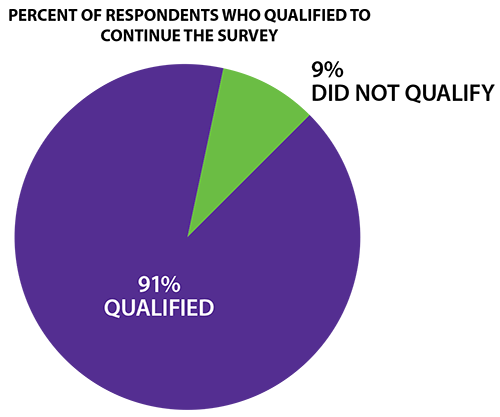
Demographic Data
Of all the qualifying respondents, 341 or 87% provided demographic data across all categories. Nearly two thirds (64%) of those that responded to these questions were between the ages of 35 and 64 years old, the vast majority were female (82%) and/or heterosexual (87%). Survey respondents were largely White (70%), however, it is important to note that the survey was created in several different languages, and that a small number of surveys that were completed in a language other than English are not included in this analysis. When analyzing responses by Race/Ethnicity, we will compare White vs Non-White as overarching categories, due to the small sample sizes of any race/ethnicity other than White.1 If race/ethnicity data is not mentioned below, there was not a significant difference in responses for that question.
1For the purposes of this report out, Non-White includes Asian/Pacific Islander, Black or African American, Hispanic/Latino, and Other. Other includes those of more than one race. “Prefer not to answer” and blanks were kept separate.
Demographics A (n=341)
Age, Percentage
14-17 years old, 1%
18-24 years old, 4%
25-34 years old, 11%
35-44 years old, 22%
45-54 years old, 19%
55-64 years old, 23%
65-74 years old, 11%
75 years or older, 5%
Prefer not to answer, 4%
Gender Identity, Percentage
Female, 82.1%
Male, 14.1%
Non-Binary, 0.3%
Transgender, 0.3%
Prefer Not to Answer, 3.2%
Demographics B (n=341)
Sexual Orientation
Asexual, 1.5%
Bisexual, 2.3%
Heterosexual, 87.1%
Gay, 0.0%
Lesbian, 0.9%
Pansexual, 0.9%
Other, 0.3%
Prefer not to answer, 7.0%
Race/Ethnicity
Asian/Pacific Islander, 6%
Black or African American, 7%
Hispanic or Latino, 8%
Native American or American Indian, 0%
White, 70%
Other, 3%
Prefer Not to Answer, 6%
There were 49 different responses on which zip code respondents reside in, the top 10 of which are included in the chart below. The top two zip codes identified were 22003, located in Annandale, at 6.7% and 22042, located in Falls Church at 6.5%.
Top 10 Zip Codes of Respondents
January-February 2020, n=341
6.7% 22003
6.5% 22042
5.9% 22030
5.0% 22309
4.7% 22043
4.1% 22015
4.1% 22032
3.8% 22153
3.5% 20120
3.2% 20121
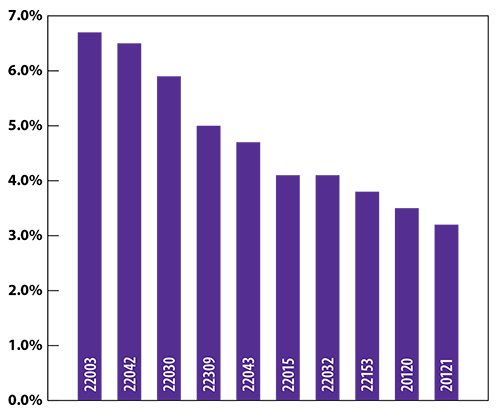
Have you, or anyone you know, experienced any of the following? Check all that apply.
There were 376 respondents who answered the question above. To focus on the prevalence of abuse, the answer “none of the above” was omitted from the chart on the right. For informational purposes, 32% of the 376 respondents had answered “none of the above.” Percentages for this question will add up to higher than 100% as respondents could elect more than one option. Again, respondents were given the option of selecting more than one type of abuse. This fact begs the question, of those who experienced or knew of abuse (254 respondents), how many types of abuse were experienced? What combinations of abuse are most prevalent? The chart to the left shows the prevalence of experiencing multiple types of abuse. Of those who experienced abuse 56% experienced the combination of Domestic Violence and Sexual Violence, followed by 37% of respondents who experienced the combination of Domestic Violence and Stalking.
Types of Abuse Experienced/Known by Survey Respondents
January-February 2020, n=376
59% Domestic Violence
45% Sexual Violence
29% Stalking
5% Sex Trafficking
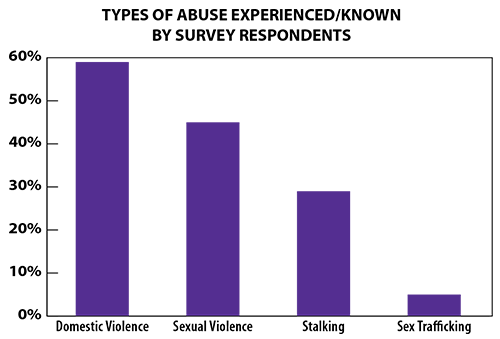
Of Those Who Experienced/Knew of Abuse, How Many Types Reported?
January-February 2020, n=254
33% 1
35% 2
27% 3
5% 4
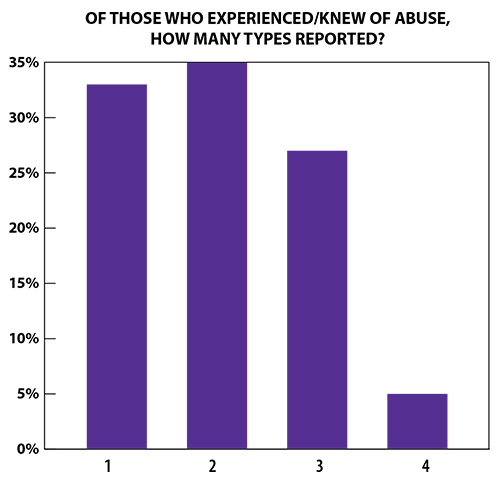
Did you or the person(s) you know receive services in Fairfax County related to the domestic violence, sexual violence, stalking, or sex trafficking?
Almost all respondents (253 respondents) who experienced or knew of someone who experienced abuse answered the question above. The majority of respondents identified that no services were received after abuse. Of the 253 respondents, 95 did receive services after abuse, 158 did not.
Did You or the Person You Know Receive Services?
January-February 2020, n=253
38% Yes
62% No
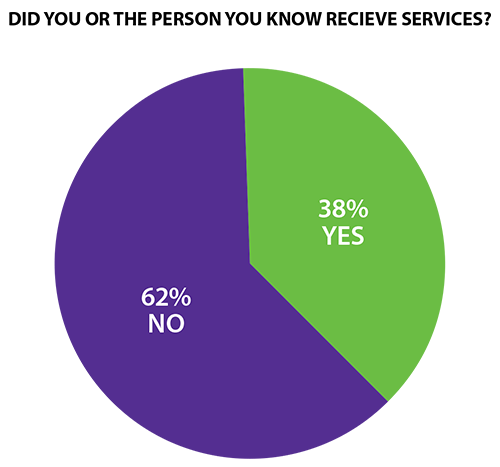
Who provided services? Check all that apply.
Almost all respondents who received services (93 respondents) identified who provided services. For the purposes of this report, the top six most frequent providers of services are highlighted in the chart below. Listed below the chart are the service providers that are not in the top six. As respondents could choose multiple service providers, percentages will add up to over 100%.
Regarding race/ethnicity, White and non-White respondents access the top service providers at approximately the same rate. The only exception to this is The Women’s Center with 32% of non-White2 respondents receiving services from The Women’s Center compared to 47% of White respondents.
2The sample size for non-White respondents is low (n=22). More data would validate if this is a true disproportionality.
Top 6 Most Frequently Used Service Providers
January-February 2020, n=93
61% Domestic Violence Action Center (DVAC)
58% Friend/Family
44% The Women's Center
43% Domestic and Sexual Violence Services (DSVS)
37% Fairfax Co. Court (e.g., protective order, divorce)
37% Fairfax Co. Court (e.g., protective order divorce)
Other service providers identified:
Community Organizations (12%)
Counseling services in Fairfax County (34%)
Other – SafeSpot Children’s Advocacy Center of Fairfax County (2%)
Religious Group, church, or institution (19%)
School (e.g., college/university or child’s school) (15%)
Shelter in Fairfax County (20%)
Unsure from where (11%)
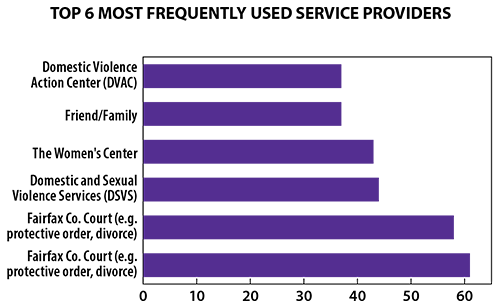
Were there things that prevented you or the person(s) you know from receiving help in Fairfax County?
As identified on the top of page 3, 158 respondents identified that services were not received after the abuse happened. 152 of these respondents answered the question asking if there were things preventing them from receiving help in Fairfax County. The majority (98 of the 158) of respondents identified that there was nothing that prevented them from receiving help. 54 respondents identified that there were things preventing them from receiving help.
Regarding race/ethnicity, non-White3 respondents had higher rates of barriers to receiving help (46%) when compared to White respondents (32%).
3Again, the sample size for non-White respondents is low (n=35). More data would validate if this is a true disproportionality.
Were there things that prevented you or the person(s) you know from receiving help in Fairfax County?
January-February 2020, n=152
64% No
36% Yes
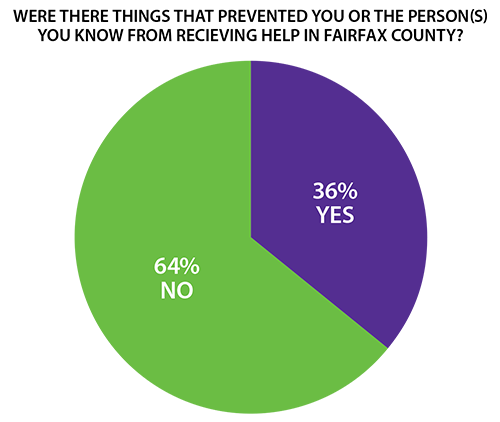
What prevented you or the person(s) you know from receiving help in Fairfax County? Check all that apply.
52 respondents who identified that there were things preventing them from receiving help chose to answer this question. Almost two thirds of the respondents who answered this question, were prevented from receiving help in Fairfax County due to not knowing where to go to get help. The chart below outlines the top three reasons why respondents were prevented from receiving help. As respondents could choose more than one option, percentages will add up to over 100%. Listed below the chart are the other prevention reasons that did not make the top three.
What prevented you or the person(s) you know from receiving help in Fairfax County?
January-February 2020, n=52
65% Did now know where to get help.
56% Fear of situation getting worse.
31% Did not identify incident(s) as domestic violence, sexual violence, stalking, or sex trafficking.
Other reasons you or the person(s) you know were prevented from receiving help:
4Refer to the demographics data section on page one regarding the data on non-English speakers.
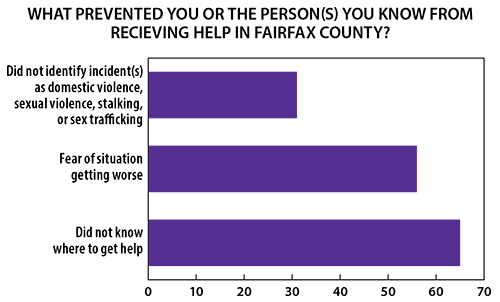
Have you heard of Fairfax County Domestic and Sexual Violence Services (DSVS) – formerly known as the Office for Women and Domestic and Sexual Violence Services (OFWDSVS)?
Of the 364 respondents to this question, 167 of them, or slightly less than half (46%) had heard of DSVS.
Percentage Who Have Heard of DSVS
January-February 2020, n=364
54% Not Heard of DSVS
46% Heard of DSVS
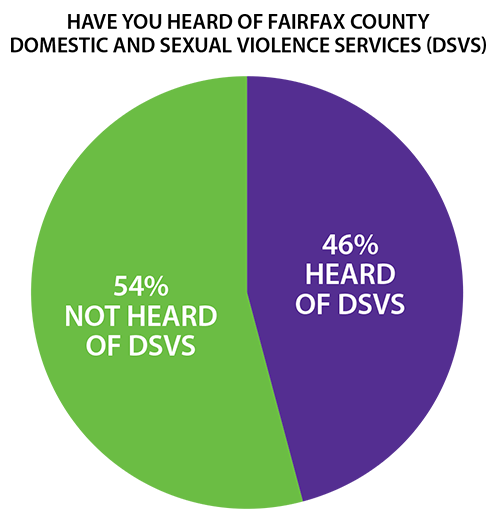
How did you learn about Fairfax County Domestic and Sexual Violence Services (DSVS)? Check all that apply.
All 167 of those from the previous question also responded to how they learned of DSVS. Just over a third (35%) of the respondents reported that they learned about it through the county website (44% of non-White5 respondents vs. 31% of White respondents), followed closely by word of mouth (29%) and a training or presentation (27% overall; 38% of non-White vs. 25% of White respondents).
Forty-three respondents (26%) chose 'other' for this response. Of those 43 that chose 'other', 22 learned of DSVS through work, such as working for the county, working as a volunteer, etc. (17% of White respondents, vs. 6% of Non-White respondents), and 9 learned through some type of event.
Top 4 Ways People Learn of DSVS
January-February 2020, n=167
35% Fairfax County website
29% World of mouth
27% Training or presentation
26% Other
5The sample size for non-White respondents is low (n=32). More data would validate if this is a true disproportionality.
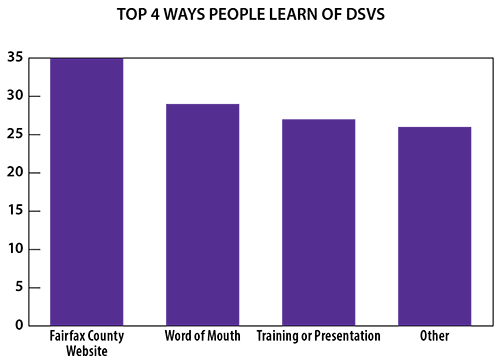
Which of the services offered by Domestic and Sexual Violence Services (DSVS) do you know about? Check all that apply.
Nearly 80% of respondents who answered the question on which services they knew about (n=153), reported that they knew about the DSVS hotline. This was followed closely by those who reported they knew about counseling for victims (74%).
Top 6 Services That People Were Aware Of
January-February 2020, n=153
78% DSVS Hotline
74% Counseling for Victims
54% Emergency Shelter
51% Counseling for Children
48% Advocacy Services
43% Services for Domestic Violence
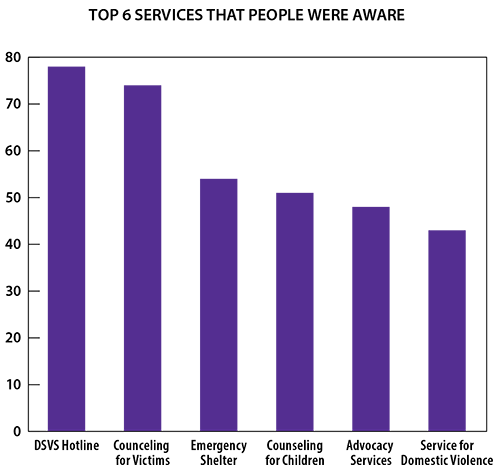
Would you use or recommend services through Fairfax County's Domestic and Sexual Violence Services (DSVS)?
Of the 153 respondents who stated in the preceding question which services they knew about, 152 selected whether or not they would actually recommend the services that Fairfax County DSVS provides. The vast majority (86%) stated that they would use or recommend DSVS services. 94% of Non-White6 respondents said yes, compared to 84% of White respondents.
6 The sample size for non-White respondents is low (n=32). More data would validate if this is a true disproportionality.
Those Who Would Use or Recommend DSVS Services
January-February 2020, n=152
86% Yes
12% Don't know/Unsure
2% No
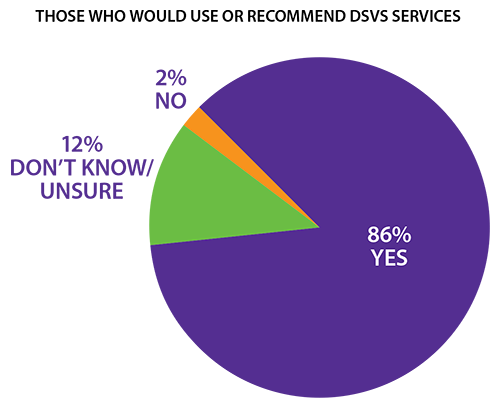
Why would you use or recommend Fairfax County's Domestic and Sexual Violence Services (DSVS)? Check all that apply.
When asked a follow up question as to reasons why they would use or recommend DSVS services, 137 (90%) of the 152 from the last question chose one or more reasons in response. Exactly three quarters of those who responded to this question selected ‘Most Services Being Free’ as a reason for doing so. Nearly two thirds (64%) selected ‘A Variety of Services’ and just over half (55%) selected ‘Expertise of Staff’ as reasons they would use or recommend DSVS Services. Only 50% of non-White7 respondents identified ‘Expertise of Staff’ as a reason that they would recommend DSVS services, compare this to 63% of White respondents who selected the same reason.
7 The sample size for non-White respondents is low (n=30). More data would validate if this is a true disproportionality.
Reasons for Using or Recommending DSVS Services
January-February 2020, n=137
75% Most services being free.
64% Variety of services.
55% Expertise of staff.
42% Services are easy to access.
Other reasons listed for using or recommending DSVS services (7%):
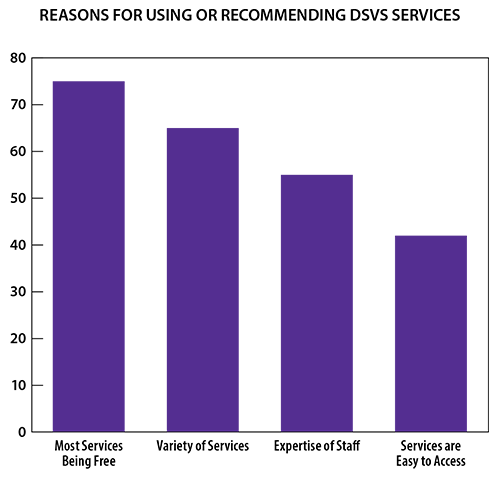
Why would you not use or recommend Fairfax County's Domestic and Sexual Violence Services (DSVS) services? Check all that apply
Only 3 respondents (2%) answered previously that they would not use or recommend DSVS services, so in the chart below, we see their follow up responses on the reasons why they wouldn’t do so. Two of the three respondents indicated that they wouldn’t use or recommend DSVS services due to fear of the situation getting worse.
Count of Reasons for Not Using or Recommending DSVS Services
January-February 2020, n=3
2 Fear of situation getting worse.
1 Other: Waste of taxpayer money given the lack of resources.
1 Other: I didn't have a good experience with services provided.
1 Other: Fairfax County Police used the inspection team from having too many calls about a 21-year-old woman that was the problem.
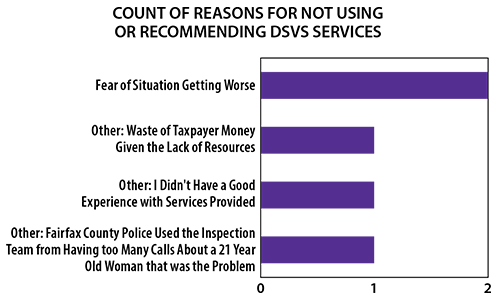
Summary
The survey showed that DSVS’s clients are largely straight white females between the ages of 35 and 64 years old, slightly more than half of whom have been the victim of domestic or sexual violence themselves. The majority of victims received services by the police department or the courts with only 44% receiving services from DSVS. In fact, only 46% of respondents had ever heard of DSVS. Of those who received services through DSVS, satisfaction was very high with 86% willing to recommend using this service to others, mostly due to the large variety of free services offered. Of those victims who did not get services in Fairfax County, lack of awareness of the services offered was the greatest obstacle, followed closely by fear that the situation would get worse.
There were some differences in responses by race, with nonwhite respondents being less likely to use the Women’s Center and being more likely to perceive that there were barriers to getting help. How non-whites learned about DSVS services differed from whites and they were more likely to recommended DSVS services.
However, these findings should be qualified due to the low percentage of non-whites who responded to the survey. And the lack of inclusion of surveys completed in any language other than English. Were this survey to be repeated, a more systemic effort should be made to ensure a representative sample of County residents are surveyed and those reposes are included in the analysis.
Download the PDF version of Fairfax County Department of Family Services The Path Forward Domestic and Sexual Violence Services Strategic Plan 2021-2026.*
*Fairfax County is committed to nondiscrimination on the basis of disability in all county programs, services and activities. To receive this information in an alternate format, call 703-324-5730 or TTY 711.
Learn about Domestic and Sexual Violence Services.
